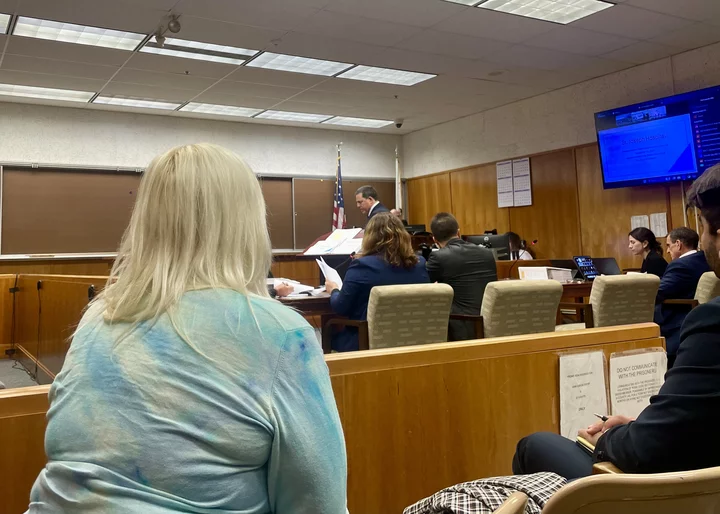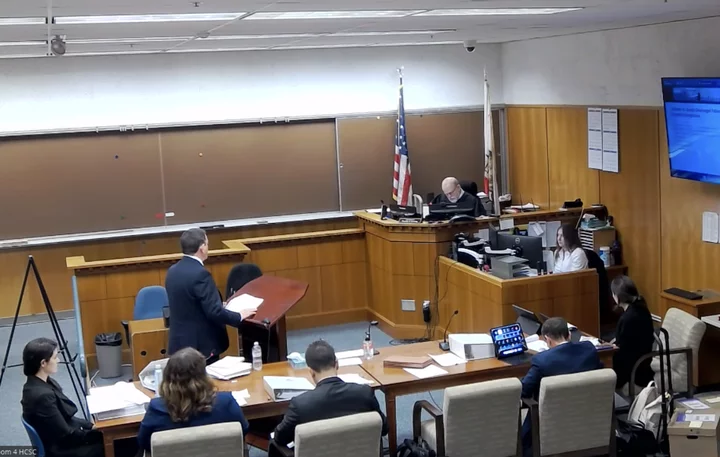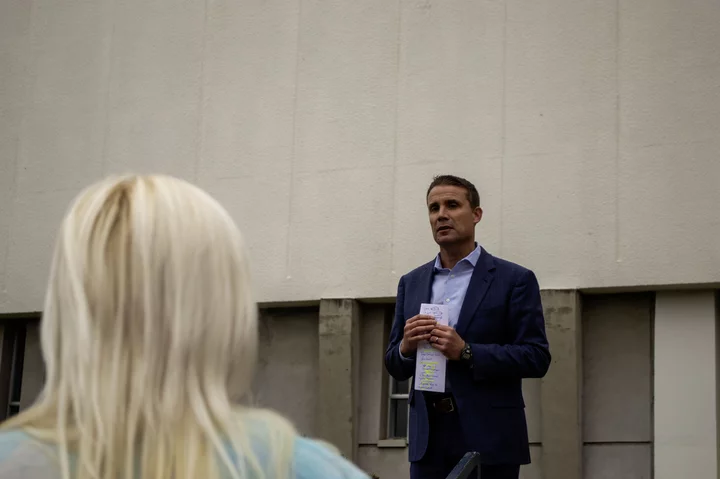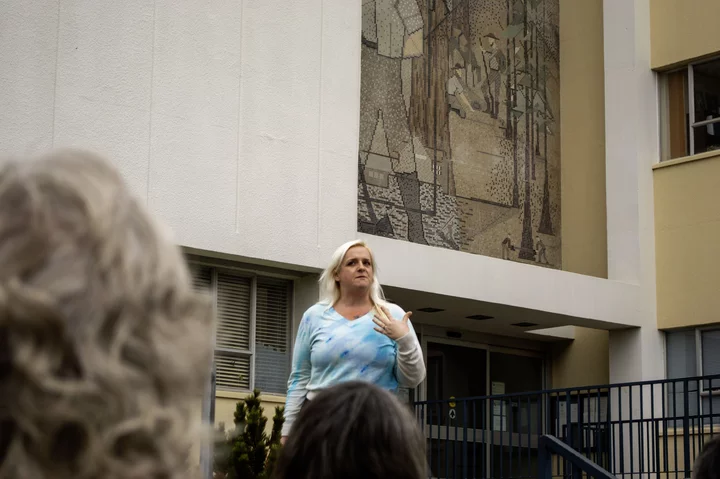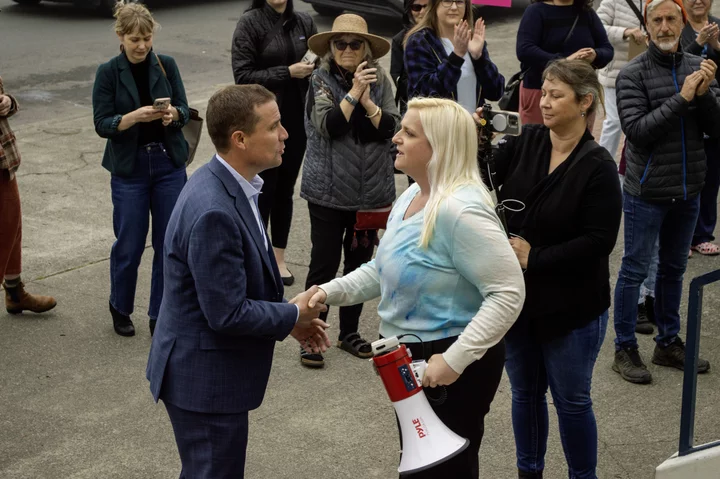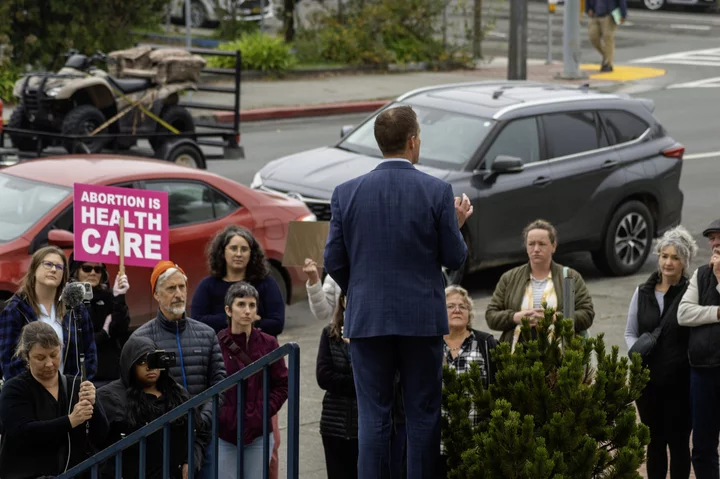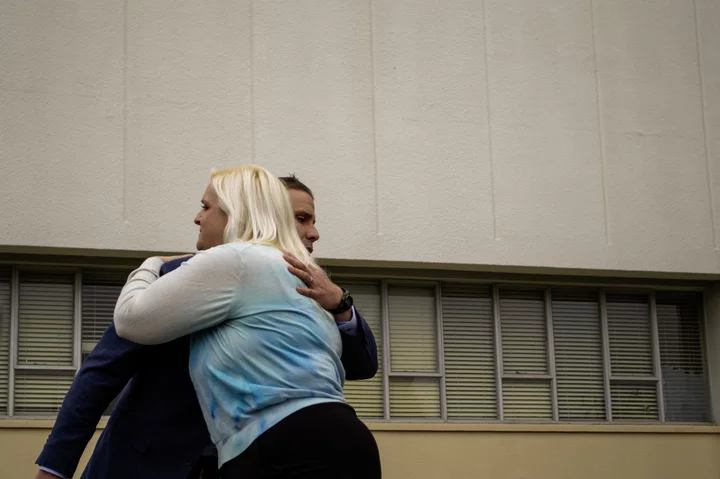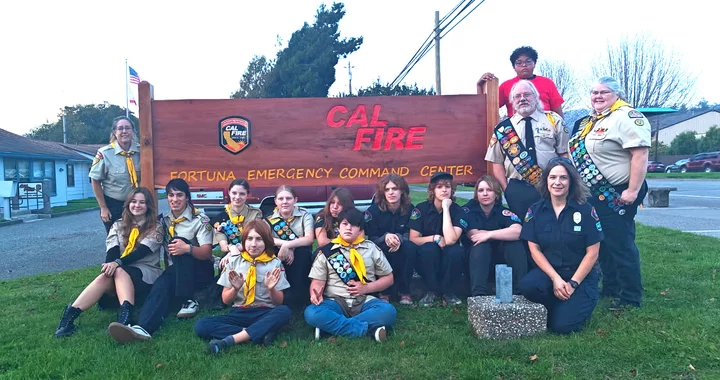Rural California Gets a Lifeline in School Funding as Congress Restores Money It Cut
Carolyn Jones / Thursday, Dec. 11 @ 7:25 a.m. / Sacramento
Students in a classroom at Achieve Charter School of Paradise in Paradise on May 21, 2025. Photo by Miguel Gutierrez Jr., CalMatters
###
This story was originally published by CalMatters. Sign up for their newsletters.
###
Rural schools and communities are poised to receive millions in funding after Congress resurrected a program left for dead a few months ago.
The Secure Rural Schools Act, which Congress passed overwhelmingly this week, is headed to President Donald Trump for final approval. It would bring $471 million for schools, roads, fire prevention, public safety and other critical needs. In California, 39 counties would share more than $40 million.
“It’s absolutely amazing,” said Jaime Green, superintendent of Trinity Alps Unified in Trinity County, which is set to receive almost $4 million from the bill. “A lot of people worked very hard to make this happen. I’ve never been more proud of our country than I am right now.”
Secure Rural Schools was created a century ago to reimburse communities that have large tracts of untaxable federal land. The program had been funded almost continuously until this year, when it apparently fell victim to the so-called Department of Government Efficiency’s push to eliminate programs it deemed wasteful.
But relentless bipartisan badgering by rural politicians and school officials apparently worked. Green, for example, visited Washington D.C. more than a dozen times to push for the bill. Rep. Doug LaMalfa, a Republican who represents much of northeastern California, hounded Speaker Mike Johnson for months until he placed it on the House calendar for a vote. A bipartisan group of more than 80 senators and representatives sent a letter to Johnson last week asking for the bill to be fast-tracked.
Public pressure, spurred in part by CalMatters coverage, also made a difference, Green and others said.
Razor-thin budgets
The money is especially important to rural communities because overall funding is so low to begin with. Rural school districts often operate on razor-thin budgets, with very little extra money to make up for swings in revenue. Trinity County, where 70% of the land is owned by the federal government, was anticipating layoffs, program cuts, deferral of costly repairs and other money-saving measures to make up for the loss of Secure Rural Schools funds.
Counties received their last Secure Rural Schools payment in March. The current bill will reimburse counties for the past nine months and cover the next two years, as well. The first checks will arrive 45 days after Trump signs the bill.
“When the program lapsed, rural schools and counties were cut short of the funding they rely on to provide basic services,” LaMalfa said. “This bill restores that funding and keeps future payments on schedule.”
He added that a long-term solution would be for the government to help rural communities re-establish their timber economy, so programs like Secure Rural Schools aren’t necessary.
Another long-term solution would be to extend Secure Rural Schools from a 3-year bill to a 5- or 10-year bill, said Allan Carver, superintendent of Siskiyou County, which will receive more than $4 million through the bill.
That would allow schools to make more permanent funding decisions — such as hiring classroom aides — and not have to continually lobby for the bill’s passage. A longer-term bill, spanning at least one presidential term, would also avoid some political skirmishes in Washington D.C., he said.
“We’re all celebrating today. This was truly an all-hands-on-deck effort,” Carver said. “But we’d love to see a permanent solution to this, so we’re not right back out there advocating a year from now.”
Other cuts on the horizon
James Gore, a Sonoma County supervisor and former president of the National Association of Counties, agreed that Secure Rural Schools should be exempt from the shifting political winds in Washington. Not only does it have strong bipartisan support, but the money is absolutely necessary for rural schools, he said.
“This is an unequivocal lifeline for kids in rural communities,” he said. “We’ll take the win, but it’s a shame that something so important was used as a negotiating tool.”
The fight is far from over, he added. Rural communities, which are disproportionately low-income compared to their urban and suburban counterparts, are facing federal cuts in Medicaid, food assistance, education and other programs which will have a far greater impact on residents’ day-to-day lives, he said.
“We all know that reform is needed,” Gore said, citing social services cuts in the Republican spending bill also called the One Big Beautiful Bill. “There’s going to be so many more fights in the next few years. Secure Rural Schools is only the first of 10 or more.”
BOOKED
Today: 9 felonies, 10 misdemeanors, 0 infractions
JUDGED
Humboldt County Superior Court Calendar: Today
CHP REPORTS
MM101 S MEN R102.20 (HM office): Traffic Hazard
0 Us199 (HM office): Traffic Hazard
ELSEWHERE
RHBB: Vehicle Hits Deer on Highway 101 Near Redcrest
RHBB: Solo Vehicle Crash Overturns Subaru on Highway 101 Near Miranda
Governor’s Office: Governor Newsom prepositions emergency resources in Southern California ahead of New Year’s Storm
In the State’s Emergency Abortion Care Lawsuit Against St. Joseph Hospital, Attorneys Recount Graphic Details and Dispute the Facts
Ryan Burns / Wednesday, Dec. 10 @ 4:53 p.m. / Courts
Anna Nusslock, a Eureka chiropractor who was allegedly denied emergency abortion care at Providence St. Joseph Hospital, watches today’s court proceedings from the front row. | Photo by Sage Alexander.
###
An attorney representing St. Joseph Northern California took an aggressive new tack today in defending against a lawsuit from California Attorney General Rob Bonta that accuses Eureka’s St. Joseph Hospital of denying patients emergency abortion care: He argued that the patients in question, Eureka chiropractor Anna Nusslock and the pseudonymous “Jane Roe,” didn’t actually experience medical emergencies while in the hospital’s care. And he accused the state of making false statements in presenting its case.
The deputy attorney general arguing in court today emphatically denied those allegations, and he accused St. Joseph Hospital of putting religious dogma ahead of women’s health.
The case is being heard by Humboldt County Superior Court Judge Timothy Canning.
The state is seeking a preliminary injunction that would compel the hospital to comply with California’s Emergency Services Law (ESL) by providing legally mandated emergency medical care. The hospital’s defense attorneys, meanwhile, argue that doctors and hospital staff did not violate the ESL with these patients, and that the injunction being sought by the state would actually force the hospital to perform elective abortions, which are forbidden by the Catholic religion. (St. Joseph Northern California is owned by the Catholic nonprofit Providence-St. Joseph).
The People’s case today was argued by Deputy AG David Houska, who began by noting that both Nusslock and Roe arrived at the hospital while suffering from previable premature preterm rupture of membranes (PPROM), a condition that occurs in pregnant patients when the amniotic sac around developing fetus breaks early.
The only definitive treatment in such cases is to terminate the pregnancy, Houska said, and yet both Nusslock and Roe were denied this necessary care at St. Joseph Hospital.
“Within hours, both were suffering from serious hemorrhages and lost a combined three and a half liters of blood,” he said, though he added that the case ultimately is not about those two women, “because what happened is not a mistake. … It was the result of a deliberate and illegal policy whereby St. Joseph withholds care from women experiencing obstetric emergencies.”
Nusslock, as previously reported, was 15 weeks pregnant with twins when she was allegedly discharged by staff at St. Joseph after doctors refused to perform an emergency abortion, despite the fact that the pregnancy had been deemed no longer viable. Staff allegedly handed Nusslock a bucket and towels on her way out the door “in case something happens in the car” on the way to Mad River Community Hospital, 12 miles north.
Roe was similarly denied “the only treatment that would actually relieve her condition” (PPROM) and made the trek to UCSF to receive treatment, a trip she described as “the worst moment of her life,” Houska said. Roe was admitted to St. Joseph Hospital during a subsequent pregnancy and again lost her fetus after being discharged in the midst of a different medical emergency, according to Houska.
He argued that while the hospital never formally wrote down or codified its policy on emergency abortion care, the policy can be inferred from statements of three separate witnesses, who used “remarkably similar language” to describe the circumstances under which physicians at St. Joe’s are allowed to terminate a pregnancy.
One doctor testified that the procedure is only allowed when the patient is clinically unstable and maternal life is in jeopardy. Another, Dr. Simon Stampe, testified that it’s only permitted when the patient is “actively dying.” And Nusslock’s own provider during her Feb. 2024 hospital visit wrote that he couldn’t provide an abortion “unless her life is at risk,” according to Houska.
The deputy AG noted that St. Joseph previously stipulated that it would follow the ESL for the duration of the trial, only to attempt to back out of the agreement when Catholic Bishop who oversees our region, Robert F. Vasa, issued a letter objecting to the agreement on ground that it would violate the Ethical and Religious Directives that govern care at Catholic medical institutions.
In the letter, Vasa said a hospital may only terminate a pre-viable pregnancy when “the only alternative is certain death of both mother and child,” according to Houska.
That may be an accurate interpretation of Catholic religious doctrine, he continued, but it doesn’t pass legal muster as a hospital policy. The hospital’s own attorneys said in a previous hearing that they can’t ignore the bishop’s guidance, and medical experts say that allowing pregnant patients to approach death before intervention puts them at risk of septic shock and multiple organ failure.
“At that point, even an aggressive and active intervention will not be enough,” Houska said. “The mortality rate of patients who progress to septic shock is estimated at 50 to 60 percent.”
By refusing to provide care until a patient’s life is in the balance, the hospital is “gambling with the health of its patients,” he concluded. “The law does not allow that.”
Back in August, Judge Canning denied the motion from St. Joseph’s attorneys to modify or set aside the stipulated agreement, despite Bishop Vasa’s objections.
Today, Houska proceeded to walk through the timeline of Nusslock’s care after she was admitted to Mad River Community Hospital, and he sought to poke holes in the defense’s arguments. He said those arguments rely on the federal Emergency Medical Treatment and Labor Act (EMTALA), which is similar to California’s ESL but not identical. And he alleged that medical experts who testified for the defense made fundamental mistakes in their analyses.
Defense attorneys have also pointed to an agreement with the state back in 2015, ahead of the merger of Providence Health & Services with St. Joseph Health. In conditions of consent for the merger, the state’s then-Attorney General agreed and mandated that St. Joseph Hospital would continue to apply the Catholic Ethical and Religious Directives on a case-by-case basis at least through 2027.
But Houska said the government cannot immunize somebody in advance for illegal conduct.
“There’s no such thing as carte blanche” under the law, he said.
Defense attorney Harvey Rochman addresses Judge Timothy Canning. | Screenshot of the Zoom feed from today’s hearing.
The defense
Once Houska had wrapped up, defense attorney Harvey Rochman, with the L.A.-based firm of Manatt, Phelps & Phillips, LLP, stepped to the lectern to present his case. He began by recalling the hospital’s founding by Catholic nuns right before the 1918 flu pandemic. They didn’t know much about medicine, but they dedicated their lives to caring for people. And St. Joseph Hospital is now “one of the best hospitals on the North Coast,” Rochman said.
He argued that it’s been hard on the physicians and employees at St. Joe’s to hear the Attorney General’s accusations and lamented “the terrible fear that has been unnecessarily stirred up.”
The AG’s Office can’t meet the burden of proof, he said, adding that the injunction would force the hospital to perform procedures that are not allowed within the Catholic religion, and which contravene of the Ethical and Religious Directives.
Rochman then launched into the allegations of false statements from Houska and from the brief provided by the Attorney General’s Office. He reminded Canning that at a previous hearing, the judge had asked Houska whether emergency abortion services were available at Mad River Community Hospital, and Houska replied, “Not to The People’s knowledge, Your Honor.”
“In fact,” Rochman said, “that was false.” While the birth center at MRCH has been closed, there are still two physicians on staff who can perform emergency abortions, though he acknowledged that they’re not always working and not on-call while away from the hospital.
Nusslock herself was sitting in the front row of the audience seats in court chambers, and she shook her head in apparent disapproval at this line of argument.
Rochman also alleged that prosecutors made false statements in documents submitted regarding Nusslock’s condition. They say she was bleeding at a worryingly high rate when she arrived at MRCH and required an immediate trip to the Operating Room for an abortion.
“And it turns out that that’s not actually true at all,” Rochman said. “It’s not even close to true.” Instead, he said, she was deemed to be in stable condition before being discharged from St. Joe’s, and after a thorough examination at MRCH, she spent hours being “expectantly managed” before undergoing surgery.
To support this narrative, Houska presented medical records from MRCH showing that Nusslock arrived around 6:42 a.m. and didn’t receive a Dilation and Curettage (often abbreviated as a D&C) until after 10:30 a.m.
“So it turns out that this whole series of events actually is a vindication for St. Joseph Hospital,” Rochman said.
Nusslock shook her head again.
Rochman put some of Nusslock’s medical records from MRCH on a flatscreen TV in the courtroom and cited a declaration from Dr. Elizabeth A. Micks, an obstetrician-gynecologist at the hospital. He said there’s nothing in the medical record to indicate that Nusslock was unstable.
“She was fine when she left St. Joseph Hospital to go get the treatment that she wanted at another hospital,” he said. Rochman also argued that Roe was likewise stable when discharged from the hospital, and that she failed to comply with orders to come back if her condition changed. Both patients received the necessary stabilizing treatment, he said, and he cited sources who say PPROM alone is not an emergency medical condition.
“The AG presented a false story throughout this case to drum up emotion in the community; to concern you, Your Honor; to [convince] everybody that that’s what had happened, and it just didn’t happen,” Rochman said.
###
During a break in the proceedings, Nusslock spoke with reporters outside the courtroom. She said that a doctor cited as an expert by the defense, Dr. Michael Gardner, is the vice president of Women and Children’s Hospital at University Health in San Antonio, Texas, adding that the hospital recently made news after a 37-year-old mother named Tierra Walker, who was pregnant with twins, died from preeclampsia after being unable to access an emergency abortion.
Nusslock also argued that Rochman had mischaracterized her treatment at MRCH and that her surgery was delayed in part due to low staffing there.
“I was not being managed; I was not being examined,” she said. “I was begging for help still.”
She remarked on the challenge of sitting through the court hearing.
“It’s really hurtful to listen to them misrepresent my experience,” she said.
The prosecution’s response
Following a lunch break, Houska pushed back against the accusations that he’d misled the court and the public about critical facts in the case. And he returned to the matter of Bishop Vasa’s letter. The standard of care spelled out in that letter — that abortion care should only be given when death is otherwise certain — is, in fact, the standard that St. Joseph intends to take forward, he argued.
He cited testimony from the prosecution’s own expert witnesses saying that PPROM, when left untreated, leads to serious medical jeopardy in a significant number of cases. Both Nusslock and Roe were determined to be at high risk of deterioration, he said.
As for the allegation that he’d lied about the availability of emergency abortion care at MRCH, Houska said, “Emergencies happen 24 hours a day, seven days a week,” so in order for a specific service to be considered “available,” it needs to accessible around the clock.
Regarding the timeline of Nusslock’s care at MRCH, Houska said the record does, in fact, show that she was bleeding upon arrival, and Nusslock herself testified as much. He cited testimony in which she said that by the time she was admitted, she had passed an apple-sized blood clot.
In closing, Houska said, “Your Honor, we’re asking for an injunction that requires them to follow the law.”
Canning said he would take the matter under submission. He has 90 days to deliver a verdict, and he said he may wind up taking the majority of that. The stipulated agreement between the parties — which Bishop Vasa objected to — will remain in effect while Canning considers the case.
###
UPDATE: This post was updated on Dec. 11 at 11:48 a.m. to include more detail from the defense’s testimony regarding Nusslock’s medical records.
###
CORRECTION: This post initially misspelled David Houska’s name. The Outpost regrets the error.
###
PREVIOUSLY
- Attorney General Sues St. Joseph Hospital for Denying a Woman Emergency Abortion Care
- Providence Offers ‘Profound Apologies’ to Woman Denied Emergency Abortion Care at St. Joseph Hospital
- A Local Doctor Urged St. Joseph Hospital to Change Its Anti-Abortion Policies Long Before State Lawsuit, According to Court Declaration
- BREAKING: St. Joseph Hospital Denies Allegations in State Abortion Care Lawsuit But Agrees to Follow State Health Care Laws as the Case Proceeds
- Judge Signs Order Committing St. Joseph Hospital to Providing Emergency Abortions, At Least For the Duration of AG Lawsuit
- Citing Religious Freedom and Catholic Doctrine, St. Joseph Health Challenges State’s Emergency Abortion Care Lawsuit on a Variety of Legal Grounds
- State Responds to St. Joseph Health’s Attempt to Get Emergency Abortion Lawsuit Dismissed
- ‘Providence Must Follow the Law’: At the Humboldt Reproductive Health Care Rally Before the Latest California vs. St. Joseph Hospital Hearing
- St. Joe’s Abortion Care Lawsuit: In a Packed Courtroom, Hospital’s Attorneys Ask Judge to Dismiss the Case
- Judge Denies St. Joseph Health’s Motion to Dismiss State Lawsuit Over Emergency Abortion Care
- Attorney General Says Providence is Trying to ‘Shirk Its Duty’ to Follow the Law In Emergency Abortion Care Suit
- Providence’s Effort to Back Out of Emergency Abortion Care Agreement Would Put Humboldt Women ‘Back in Harms’ Way,’ AG’s Office Argues in Latest Court Filing
- Judge Holds Providence St. Joseph to Prior Agreement as Emergency Abortion Care Lawsuit Proceeds
- Attorney General’s Office Files New Motion for Preliminary Injunction in St. Joseph Emergency Abortion Care Case
(PHOTOS) Sen. McGuire and Anna Nusslock Speak at Rally During St. Joseph Emergency Abortion Trial
Dezmond Remington / Wednesday, Dec. 10 @ 2:10 p.m. / Activism
Sen. McGuire addresses Anna Nusslock directly during his remarks. Photos by Dezmond Remington.
State Senator Mike McGuire spoke at a rally during a recess in the State of California-Providence trials outside the Humboldt County courthouse, held to support Anna Nusslock and reproductive rights. (Here’s a link to a story about today’s hearing.)
“I especially want to say thank you to Ms. Nusslock,” McGuire said. “[For] your strength. Your courage. Your conviction. You’re standing up and you’re standing strong to ensure that no other woman in this state faces the horrific conditions you did. You’re standing up for injustice, for all women in California.”
About a dozen people attended. Nusslock and Ferndale resident Ellie Titus also addressed the crowd, mostly composed of older attendees not too inclined to do much yelling. One of them (who asked to remain anonymous) said she was “shocked” she had to attend protests in California “in this day and age,” so long after the 1973 Roe v. Wade decision when she was 19.
Nusslock said doctors at St. Joseph Hospital denied her an abortion for religious reasons when she sought care there in Feb. 2024 after she had a miscarriage 15 weeks into her pregnancy with twins. Nusslock says they gave her a bucket full of towels and a choice between going to Mad River Hospital in Arcata or hemorrhaging to death attempting to make a trip to a hospital in San Francisco.
Nusslock addresses the crowd.
Nusslock didn’t need a megaphone.
“When I was pregnant with my daughters, I truly thought they were going to change the world,” she said. “…I went to Providence that day for a lot of reasons. I went because my doctor told me to. I went because it was close to my house, and in an emergency every second matters. And I went because they claim to care about their pregnant patients’ outcomes. Miscarriage and loss are a part of pregnancy, and if it happens to you, you deserve to be cared for with compassion, to be treated with respect and to have your dignity maintained. Providence did none of that for me.”
“Providence sent their attorneys here today to argue for the right to hurt other people like they hurt me, and this is unacceptable,” Nusslock continued. “This is cruel and this is dangerous. You meeting here today shows the world what our community thinks about Providence continuing to hurt our families. We are not okay with forcing people to suffer in their most vulnerable moments, and we will not be quiet about it.”
After McGuire finished, Nusslock told him she appreciated his attendance and said she was willing to support him in his campaign for Congress.
She also told the Outpost that she appreciated everyone who came.
“I was so scared for my neighbors and my friends; I couldn’t live with myself if they went through what I went through without me standing up to fight back against it,” she said. “I was ready to do it alone, but the fact that I don’t have to gives me all the hope in the world.”
Local Farmer Blake Alexandre Appears Alongside RFK Jr., Dr. Oz, Brooke Rollins at the Trump Administration’s Launch of a New Pilot Program to Support Regenerative Farming
Hank Sims / Wednesday, Dec. 10 @ 1 p.m. / D.C.
Alexandre’s address starts at about the 25-minute mark in the video above.
This morning, Blake Alexandre of Alexandre Family Farms appeared at a press conference announcing the Trump Administration’s launch of a $700 million pilot program designed to promote regenerative practices on American farms.
Alexandre, a Ferndale native, runs his family’s dairy and poultry operation out of Crescent City, though it still manages cattle in Humboldt County as well.
Well known for its organic offerings and “A2/A2” milk, Alexandre Family Farms has long been a proponent of regenerative farming, an approach that pays close attention to the health of the soil and the ecosystem, emphasizing nature-mimicking processes to keep land productive.
“Regenerative farming is simply farming in harmony with nature, in the way God intended, or our maker intended,” Alexandre said, after being introduced by Secretary of Agriculture Brooke Rollins.
He noted that Alexandre Family Farms was the first certified regenerative farm in the United States, and made a case that food produced on such farms are more nutrient-rich than it would be otherwise.
Not everyone is pleased with the farm’s operations. Early last year, a national nonprofit called Farm Forward issued a report alleging that Alexandre Family Farms employed inhumane practices on its animals. In a statement sent to the Outpost, the company said the report was “part of an ongoing campaign by an animal rights activist group questioning the validity of humane farming certifications.” The report prompted a pair of lawsuits, neither of which has been finally resolved.
###
Press release from the USDA:
Today, U.S. Secretary of Agriculture Brooke L. Rollins, alongside U.S. Health and Human Services Secretary Robert F. Kennedy, Jr., and Centers for Medicare & Medicaid Services Administrator Dr. Mehmet Oz announced a $700 million Regenerative Pilot Program to help American farmers adopt practices that improve soil health, enhance water quality, and boost long-term productivity, all while strengthening America’s food and fiber supply.
Building off the Make Our Children Healthy Again Strategy released in September, the U.S. Department of Health and Human Services (HHS) is also investing in research on the connection between regenerative agriculture and public health, as well as developing public health messaging explaining this connection.
“Protecting and improving the health of our soil is critical not only for the future viability of farmland, but to the future success of American farmers. In order to continue to be the most productive and efficient growers in the world, we must protect our topsoil from unnecessary erosion and improve soil health and land stewardship. Today’s announcement encourages these priorities while supporting farmers who choose to transition to regenerative agriculture. The Regenerative Pilot Program also puts Farmers First and reduces barriers to entry for conservation programs,” said Secretary Brooke Rollins. “This is another initiative driven by President Trump’s mission to Make America Healthy Again. Alongside Secretary Kennedy, we have made great strides to ensure the safe, nutritious, and affordable food our great farmers produce make it to dinner tables across this great country.”
“In September, under President Trump’s leadership, we released the MAHA Strategy Report, which includes a full section on soil health and land stewardship,” said HHS Secretary Kennedy. “Today’s regenerative farming announcement directly advances that deliverable. If we intend to Make America Healthy Again, we must begin by restoring the health of our soil.”
“We cannot truly be a wealthy nation if we are not also a healthy nation. Access to wholesome, nutritious, and affordable foods is a key tenet of the Make America Healthy Again agenda, which President Trump has directed this administration to execute across all government agencies,” said CMS Administrator Dr. Mehmet Oz. “I commend Secretary Rollins and Secretary Kennedy for today’s efforts to strengthen our nation’s food supply.”
Protecting Soil and Reducing Production Costs
In response to the Dust Bowl in the 1930s, Congress created the USDA Natural Resources Conservation Service (NRCS) to help people help the land and improve conservation of the nation’s soil and water resources.
This action led to improved soil health and natural resources management which, in turn, has led to increased productivity. Between 1948 and 2021, total U.S. farm production increased 190% while total farm inputs—such as land, labor, and water—decreased 2% in the same period.
However, current conservation programs at USDA have become overly burdensome and farmers are bogged down with red tape whenever they try to adopt soil health and regenerative agriculture practices. Even with the improved soil health since the creation of NRCS, USDA data shows that farmers recently reported that 25% of acres had water-driven erosion concerns and 16% of acres had wind-driven erosion concerns.
The Regenerative Pilot Program directly addresses these challenges by cutting administrative burdens for producers, expanding access to new and beginning farmers, and boosting yields and long-term soil resilience across operations.
About the Regenerative Pilot Program
Administered by NRCS, this new Regenerative Pilot Program delivers a streamlined, outcome-based conservation model—empowering producers to plan and implement whole-farm regenerative practices through a single application. The initiative highlights USDA’s commitment to putting Farmers First and advancing the Make America Healthy Again (MAHA) agenda by building a healthier, more resilient food system.
In FY2026, the Regenerative Pilot Program will focus on whole-farm planning that addresses every major resource concern—soil, water, and natural vitality—under a single conservation framework. USDA is dedicating $400 million through the Environmental Quality Incentives Program (EQIP) and $300 million through the Conservation Stewardship Program (CSP) to fund this first year of regenerative agriculture projects.
Producers can now bundle multiple regenerative practices into one application, streamlining the process and increasing flexibility for operations. The program is designed for both beginning and advanced producers, ensuring availability for all farmers ready to take the next step in regenerative agriculture.
Chief’s Advisory Council
To keep the Regenerative Pilot Program grounded in practical, producer-led solutions, NRCS is establishing the Chief’s Regenerative Agriculture Advisory Council. The Council will meet quarterly, with rotating participants, to advise the Chief of NRCS, review implementation progress, and help guide data and reporting improvements. Its recommendations will shape future USDA conservation delivery and strengthen coordination between the public and private sectors.
Public + Private Partnerships
There is a growing desire among private companies to fund conservation practices that improve natural resources management. This announcement unlocks new opportunities for USDA to leverage existing authorities to create public-private partnerships within NRCS conservation programs. These partnerships will allow USDA to match private funding, in turn stretching taxpayer dollars further, and bringing new capacity to producers interested in adopting regenerative practices.
Companies interested in partnering with USDA NRCS in the Regenerative Pilot Program can email regenerative@usda.gov for more information.
How to Apply
Farmers and ranchers interested in regenerative agriculture are encouraged to apply through their local NRCS Service Center by their state’s ranking dates for consideration in FY2026 funding. Applications for both EQIP and CSP can now be submitted under the new single regenerative application process.
Man Walking Around ‘With His Shorts Pulled Down’ Near Pine Hill Elementary Arrested for Indecent Exposure, Sheriff’s Office Says
LoCO Staff / Wednesday, Dec. 10 @ 11:25 a.m. / Crime
Press release from the Humboldt Count Sheriff’s Office:
On Dec. 9, 2025, at 10:50 a.m. Humboldt County Sheriff’s deputies responded to the area of Vance St. and Bar View Ct. in Eureka following a report of an adult male walking near Pine Hill Elementary School with his shorts pulled down, exposing himself.
Upon arrival, deputies contacted the individual, later identified as 37-year-old Kevin Charles Astry. Astry immediately exhibited hostile and aggressive behavior toward deputies. He refused to comply with verbal commands and actively resisted arrest, physically assaulting one deputy during the handcuffing process.
Deputies were ultimately able to gain control of Astry, and he was taken into custody without further incident.
Astry was transported to the Humboldt County Correctional Facility where he was booked on the following charges:
- P.C. 314(1) Indecent Exposure
- P.C. 243(b) Battery on peace officer / emergency personnel
- P.C. 69(a) Obstruct/Resist executive officer
Anyone with information about this case or related criminal activity is encouraged to call the Humboldt County Sheriff’s Office at (707) 445-7251 or the Sheriff’s Office Crime Tip line at (707) 268-2539.
Judge Orders Trump to End National Guard Deployment, Calls LA Mission ‘Profoundly Un-American’
Nigel Duara / Wednesday, Dec. 10 @ 11:11 a.m. / Sacramento
Demonstrators protest against recent ICE immigration raids as National Guard officers stand guard in front of a federal building in Los Angeles on June 9, 2025. Photo by Ted Soqui for CalMatters
###
This story was originally published by CalMatters. Sign up for their newsletters.
###
A federal judge has ordered the National Guard to leave Los Angeles and return to Gov. Gavin Newsom’s control in a stern rebuke of the Trump administration’s contention that it can leave troops in the city indefinitely.
The order handed down today goes into effect at noon on Monday.
“It is profoundly un-American to suggest that people peacefully exercising their fundamental right to protest constitute a risk justifying the federalization of military forces,” U.S, District Court Judge Charles Breyer wrote in the opinion.
The Los Angeles case is one of several challenging Trump’s deployment of the National Guard in liberal cities, including Chicago and Portland. The U.S. Supreme Court is weighing a case on Trump’s call-up of troops to Chicago, which could further determine whether the domestic mobilizations are constitutional.
Breyer in June issued a separate decision against Trump’s Los Angeles deployment, but the 9th Circuit Court of Appeals blocked the ruling from taking effect and allowed the troops to stay.
The Trump administration used Section 12406 of the U.S. Code to justify sending National Guard troops to Los Angeles in early June, when aggressive immigration enforcement operations led to protests. The administration issued similar orders in August and again in October, each time citing the clause that permits Trump to federalize National Guard troops if “the President is unable with the regular forces to execute the laws of the United States.”
In each case, the Trump administration argued that the conditions in Los Angeles in early June justified sending in the National Guard. Trump mobilized 4,000 of the state’s National Guard troops in response to two days of occasionally volatile protests against federal immigration raids in Southern California.
Before Trump’s federalization of those troops, at no time in U.S. history was the law invoked without the consent of the state governor. Use of the law is exceedingly rare: It was used just once before June by President Richard Nixon to mobilize troops during a postal worker strike in 1970.
“it defies the record — and common sense — to conclude that risks stemming from protests — in August, October, or even present day — could not have been sufficiently managed without resorting to the National Guard,” wrote Breyer, the brother of retired Supreme Court justice Stephen Breyer.
There are three conditions that presidents can use to invoke Section 12406: If the country is invaded or in danger of invasion; if there is a rebellion or danger of a rebellion against the U.S. government; or if the president cannot enforce the nation’s laws with regular forces.
The Trump administration focused on the last one, arguing that previous court rulings found that the president need only be “significantly impeded” from executing the country’s laws, rather than being completely “unable” to execute them, to comply with Section 12406, and argued that the existing risk of further protests justified the continued presence of the National Guard.
Breyer rejected that argument, saying that the mere threat of protests or uprisings compromising the president’s ability to execute the country’s laws is not enough to justify federalization of the National Guard.
“if federalization justified federalization, it would become a positive feedback loop that perpetually rationalized federal control of state troops,” Breyer wrote.
The Trump administration, in its briefings, argued both that the federal mission had succeeded and conditions in Los Angeles had improved, but said the situation still required the presence of National Guard troops.
“Their assertion that ‘[t]here remains an inability to execute the laws … in California’ is not only unsupported, but actually borders on a misrepresentation,” Breyer wrote.
Breyer also warned that the Trump administration’s justification for federalizing National Guard troops, if allowed to proceed, would set a dangerous precedent.
The Trump administration “confirmed their position that, after an initial federalization, all extensions of federalization orders are utterly unreviewable, forever,” Breyer wrote.
“That is shocking. Adopting Defendants’ interpretation of Section 12406 would permit a president to create a perpetual police force comprised of state troops, so long as they were first federalized lawfully.”
Hooray for the Fortuna Teens Who Refurbished the Signage for Calfire’s Local Emergency Command Center
LoCO Staff / Wednesday, Dec. 10 @ 11 a.m. / Our Culture
Photos: Calfire.
Press release from Calfire Humboldt-Del Norte Unit:
The Fortuna Community Emergency Response Team (CERT) recently dedicated time from their busy schedules to help restore one of CAL FIRE’s local signs, demonstrating their ongoing commitment to community service and disaster readiness. The project highlights the strong partnership between CERT and CAL FIRE, as well as their shared goal of supporting public safety across Humboldt County.
The sign refinishing project was led by Emily Mazzone-Clementi, leader of Fortuna Teen CERT, who oversaw the effort from start to finish, along with Dr. Lane Thomsen of the Fortuna Junior Academy. Two youth groups collaborated on the restoration: Fortuna Teen CERT and the Fortuna Pathfinder youth, a local organization similar to Scouts and part of the Seventh-day Adventist Youth program. Their teamwork underscores the important role young volunteers play in supporting and strengthening the community.
Battalion Chief Andrew Gonzales of the CAL FIRE Fortuna Command Center expressed his appreciation for the team and the ongoing partnership. “We are grateful for the Fortuna CERT volunteers and the work they do,” he said. “Whether responding to emergencies or supporting community projects like this, their efforts strengthen our mission and help keep residents safe. Their dedication is recognized and truly appreciated.”
The Fortuna Emergency Command Center supports CAL FIRE operations by handling emergency communications and dispatching resources throughout the region. The center plays an important role in ensuring timely and coordinated response during incidents.
Community Emergency Response Teams (CERT) are trained volunteers who empower communities to be ready, resilient, and confident in the face of emergencies. Through hands-on learning and essential preparedness training, CERT equips individuals and organizations with the practical skills needed to protect themselves and support others during the critical first hours and days of a disaster.
Fortuna’s CERT team operates under the guidance and support of the Fortuna Fire District and works closely with other CERT members throughout the Humboldt County CERT Council. Together, these volunteers transform readiness into action and neighbors into lifesavers.


